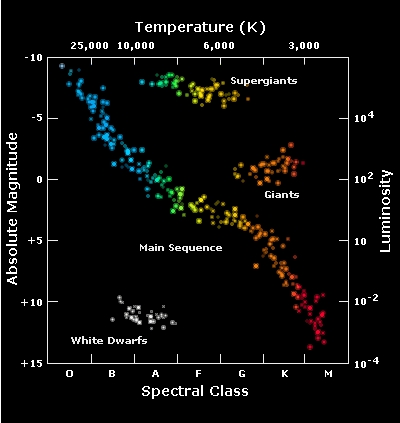The first step in analyzing which of the 28 closest stars are the best candidates for human habitability is to separate them out by spectral class.
19 of the 28, or 68%, are M class red dwarf stars. These will be dealt with as a separate topic, because although they are definitely second-tier (but definitely not bottom-tier) candidates, there are an awful lot of them.
2 of the stars are class DA white dwarfs, which can reasonably be eliminated from the list. These two happen to be companions of class A star Sirius A and class F star Procyon A. The presence of white dwarf companions probably eliminates these two stars as well.
There are no class O or class B stars in the list, which is fine since they would have been eliminated anyway. Class A stars would be marginal, but the only class A candidate is Sirius. Given that Sirius also has a companion white dwarf, it is reasonable to remove Sirius from the list.
That leaves us with our "A list" of Main Sequence F,G and K class stars.
The two Alphas Centauri are G2 (like our sun) and K1 respectively, and our closest neighbors at 4.4 light years away. As an added bonus, red dwarf Proxima Centauri is right on the way to them, so we would get three reasonable candidates for the price of one.
Epsilon Eridani is class K2, at a distance of 10.5 light years.
61 Cygni is a binary system of a K5 and K7 class orange dwarf stars. It is 11.4 light years away.
Epsilon Indi is a K5 star with two brown dwarf companions, 11.8 light years away. Margaret Turnbull considers Epsilon Indi to be our single best candidate for a truly earth-like planet within some 20 light years of earth.
Tau Ceti is a G8 star 11.9 light years away. Tau Ceti was the reason I chose the otherwise arbitrary distance of 12 light years; I wanted Tau Ceti to be included. Tau Ceti is ranked as target number three for the Terrestrial Planet Finder orbital telescope after the Alphas Centauri, if it is ever completed and launched.
Each of these five candidates warrant their own post here, which will be forthcoming.
The next 32 stars after Tau Ceti are all white, red or brown dwarfs. After that is K5 class Groombridge 1618 at about 16 light years followed by a lot more red and white dwarfs. But we have plenty to play with here already, and the rules don't change the further out we go.

No comments:
Post a Comment